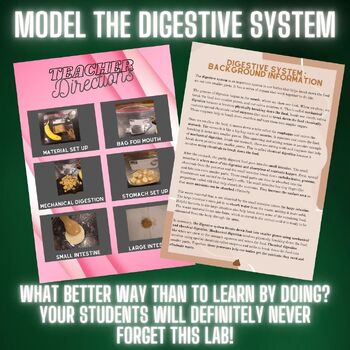Making Poop! Modeling the Digestive System Lab (Digestive System Model)
Science Explorin with Mar and Lauren
21 Followers
Grade Levels
5th - 10th
Subjects
Resource Type
Standards
NGSSMS-LS1-7
NGSSMS-LS1-3
Formats Included
- Google Drive™ folder
Pages
13 pages
Science Explorin with Mar and Lauren
21 Followers

Made for Google Drive™
This resource can be used by students on Google Drive or Google Classroom. To access this resource, you’ll need to allow TPT to add it to your Google Drive. See our FAQ and Privacy Policy for more information.
What educators are saying
Students were fully engaged in this lab! There was great inquiry as we progressed. Very cheap lab and quick set up.
Great activity to engage students in understanding the structure and function of each part of the digestive system.
Also included in
- Looking to spice up your Human Body Systems Unit? You have to get this bundle of student-tested and approved resources!This bundle includes - Making Poop! Modeling the Digestive System (Digestive System Model)- Disease Case Study Inquiry Lesson (John Snow, Cholera, and 1850s England)- Human Body SyPrice $20.00Original Price $30.00Save $10.00
Description
Get ready to be thoroughly grossed out with your students! This lab will have you modeling the process of digestion and it's a lab your students won't forget.
This resource includes colorful directions for each station and two editable student labs : one for printing and one for digital learning management systems.
The required materials are easy to find : water, graham crackers, bananas, small plastic bag, big plastic bag, paper towels, and a funnel.
Total Pages
13 pages
Answer Key
N/A
Teaching Duration
45 minutes
Last updated 11 months ago
Report this resource to TPT
Reported resources will be reviewed by our team. Report this resource to let us know if this resource violates TPT’s content guidelines.
Standards
to see state-specific standards (only available in the US).
NGSSMS-LS1-7
Develop a model to describe how food is rearranged through chemical reactions forming new molecules that support growth and/or release energy as this matter moves through an organism. Emphasis is on describing that molecules are broken apart and put back together and that in this process, energy is released. Assessment does not include details of the chemical reactions for photosynthesis or respiration.
NGSSMS-LS1-3
Use argument supported by evidence for how the body is a system of interacting subsystems composed of groups of cells. Emphasis is on the conceptual understanding that cells form tissues and tissues form organs specialized for particular body functions. Examples could include the interaction of subsystems within a system and the normal functioning of those systems. Assessment does not include the mechanism of one body system independent of others. Assessment is limited to the circulatory, excretory, digestive, respiratory, muscular, and nervous systems.





